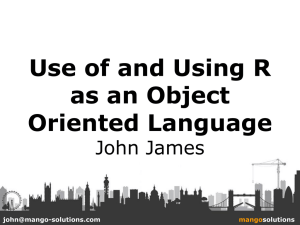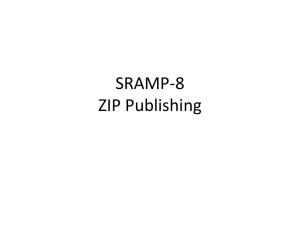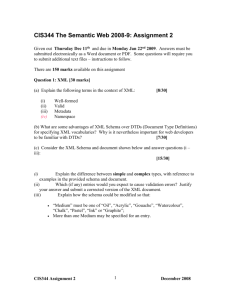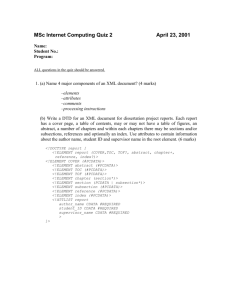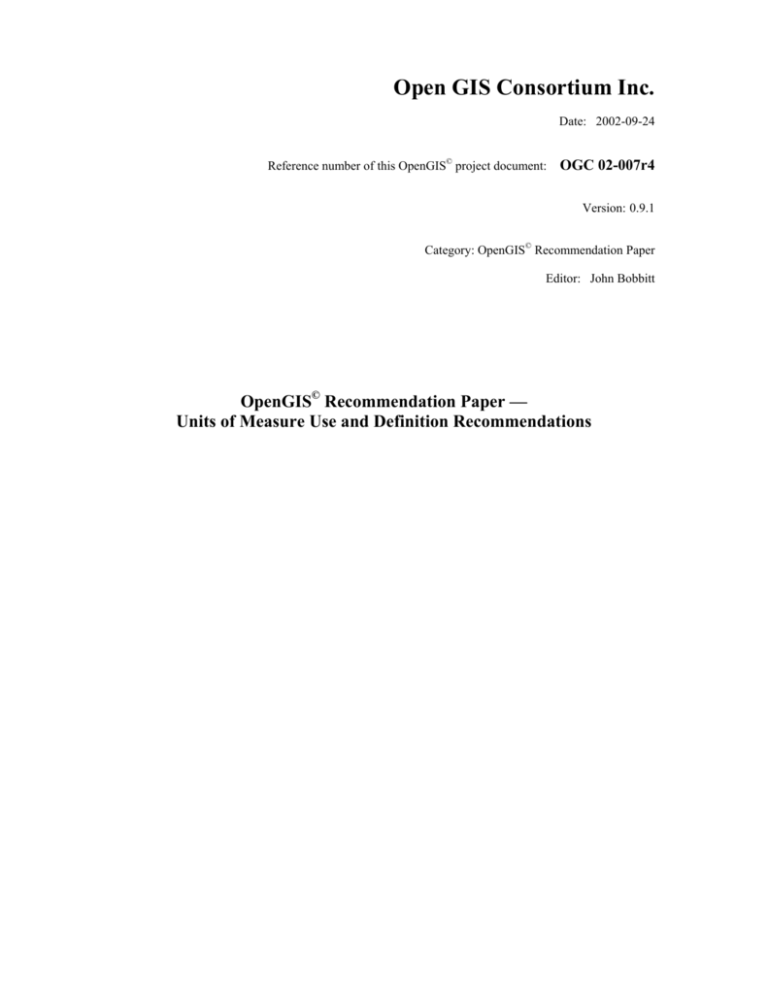
Open GIS Consortium Inc.
Date: 2002-09-24
Reference number of this OpenGIS© project document:
OGC 02-007r4
Version: 0.9.1
Category: OpenGIS© Recommendation Paper
Editor: John Bobbitt
OpenGIS© Recommendation Paper —
Units of Measure Use and Definition Recommendations
OGC 02-007r4
Copyright notice
Copyright 2002 Petrotechnical Open Software Consortium, Inc
Copyright 2002 Open GIS Consortium, Inc
This document is based on material taken from the Units of Measure Recommendation Document,
http://www.posc.org/ComponentDocs/uomFinalRecs.doc
The license notice is located at http://www.posc.org/Specifications/Epicentre_V30/license.html .
This material may be freely used and distributed, and in no way restricted by other users.
This document does not represent a commitment to implement any portion of this specification in any company’s products.
OGC’s Legal, IPR and Copyright Statements are found at http://www.opengis.org/legal/ipr.htm
NOTICE
Permission to use, copy, and distribute this document in any medium for any purpose and without fee or royalty is hereby granted,
provided that you include the above list of copyright holders and the entire text of this NOTICE.
We request that authorship attribution be provided in any software, documents, or other items or products that you create pursuant to
the implementation of the contents of this document, or any portion thereof.
No right to create modifications or derivatives of OGC documents is granted pursuant to this license. However, if additional
requirements (as documented in the Copyright FAQ at http://www.opengis.org/legal/ipr_faq.htm) are satisfied, the right to create
modifications or derivatives is sometimes granted by the OGC to individuals complying with those requirements.
THIS DOCUMENT IS PROVIDED "AS IS," AND COPYRIGHT HOLDERS MAKE NO REPRESENTATIONS OR
WARRANTIES, EXPRESS OR IMPLIED, INCLUDING, BUT NOT LIMITED TO, WARRANTIES OF MERCHANTABILITY,
FITNESS FOR A PARTICULAR PURPOSE, NON-INFRINGEMENT, OR TITLE; THAT THE CONTENTS OF THE
DOCUMENT ARE SUITABLE FOR ANY PURPOSE; NOR THAT THE IMPLEMENTATION OF SUCH CONTENTS WILL
NOT INFRINGE ANY THIRD PARTY PATENTS, COPYRIGHTS, TRADEMARKS OR OTHER RIGHTS.
COPYRIGHT HOLDERS WILL NOT BE LIABLE FOR ANY DIRECT, INDIRECT, SPECIAL OR CONSEQUENTIAL
DAMAGES ARISING OUT OF ANY USE OF THE DOCUMENT OR THE PERFORMANCE OR IMPLEMENTATION OF THE
CONTENTS THEREOF.
The name and trademarks of copyright holders may NOT be used in advertising or publicity pertaining to this document or its contents
without specific, written prior permission. Title to copyright in this document will at all times remain with copyright holders.
RESTRICTED RIGHTS LEGEND. Use, duplication, or disclosure by government is subject to restrictions as set forth in subdivision
(c)(1)(ii) of the Right in Technical Data and Computer Software Clause at DFARS 252.227.7013
OpenGIS® is a trademark or registered trademark of Open GIS Consortium, Inc. in the United States and in other countries.
Warning
This document is not an OGC Standard. It is distributed for review and comment. It
is subject to change without notice and may not be referred to as an OGC Standard.
Recipients of this document are invited to submit, with their comments, notification
of any relevant patent rights of which they are aware and to provide supporting
documentation.
Document type:
Document subtype:
Document stage:
Document language:
ii
OpenGIS© Publicly Available Document
Recommendation Paper
Final
English
© OGC 2002 – All rights reserved
OGC 02-007r4
Contents
i.
Preface ................................................................................................................... iv
ii.
Author ................................................................................................................... iv
Foreword ............................................................................................................................ v
Introduction ...................................................................................................................... vi
1
Scope....................................................................................................................... 7
2
2.1
2.2
Conventions............................................................................................................ 7
Symbols (and abbreviated terms) ........................................................................ 7
XML use conventions............................................................................................ 7
3
3.1
3.2
3.3
3.4
Using a unit of measure ........................................................................................ 8
Introduction ........................................................................................................... 8
Abbreviation for units of measure....................................................................... 8
Measure data type ................................................................................................. 8
Unit of measure reference type ............................................................................ 9
4
4.1
4.2
4.3
4.4
4.5
4.6
4.7
4.7.1
Defining a unit of measure.................................................................................... 9
UOM value reference ............................................................................................ 9
UOM reference by symbol.................................................................................. 10
Remote reference data type................................................................................ 10
Defining meaning of a unit of measure.............................................................. 11
Definition of a base unit ...................................................................................... 11
Definition of unit of measure that is not a base unit ........................................ 11
Angular measure ................................................................................................. 12
Implementation of the dms element .................................................................. 13
5
Terms and definitions ......................................................................................... 14
Bibliography .................................................................................................................... 16
© OGC 2002 – All rights reserved
iii
OGC 02-007r4
i.
Preface
This document is a public OGC Recommendation Paper, providing recommendations for
use and definition of the units of measure used for numerical quantities. The
recommendations take the form of Best Practices.
ii.
Author
Name:
John Bobbitt
Address:
Petrotechnical Open Software Corporation
9801 Westheimer, Suite 450
Houston, Texas 77042
Phone:
713-267-5174
Email:
bobbitt@posc.org
iv
© OGC 2002 – All rights reserved
OGC 02-007r4
Foreword
This recommendation paper provides recommendations for use and definition of the units
of measure used for numerical quantities.
Many of these recommendations are stated using XML and XML Schema. The concepts
of use are still valid when not using XML. The implementation, of course, will be
different.
This document partially replaces OGC Discussion Paper 01-044r2: Units of Measure and
Quantity Datatypes. This document contains a listing of the main recommendations.
Attention is drawn to the possibility that some elements of this document may be the
subject of patent rights. The Open GIS Consortium Inc. shall not be held responsible for
identifying any or all such patent rights.
© OGC 2002 – All rights reserved
v
OGC 02-007r4
Introduction
The basic information needed to understand a measured value is the value and the unit of
measure. Eight different ways, and various options of these ways, to tie these two pieces
of information were identified. The goal of this project was to develop a preferred way to
implement this information in XML.
In addition, it was noted that a symbol for a unit of measure was not sufficient to identify
it. Thus, this recommendation paper also defines a best practice for giving the meaning of
a unit of measure.
vi
© OGC 2002 – All rights reserved
OGC 02-007r4
OpenGIS© Recommendation Paper — Units of Measure Use and
Definition Recommendations
1
Scope
This OpenGIS© Recommendation Paper provides recommendations for use and definition
of the units of measure used for numerical quantities. These recommendations are more
widespread than OpenGIS only, and are being proposed at other organizations, including
POSC, W3C, CSIRO, PIDX, and OASIS.
These recommendations are given as best practices, and are not intended to be rigidly
followed. However, it is recommended that variations from these practices be considered
for their negative effects on interoperability.
The recommendations are stated for a single, measure value. However, many of the same
structures apply to arrays and tuples of values. XML Schema and documents that capture
arrays of values, and tuples of values, should consider the patterns of these
recommendations, and follow them where appropriate.
Many of these recommendations are stated using XML and XML Schema. These
recommendations should be followed even when XML is not being used.
2
Conventions
2.1
Symbols (and abbreviated terms)
ISO
International Organization for Standardization
OGC
Open GIS Consortium
UOM
Unit of Measure
W3C
World Wide Web Consortium
XML
eXtended Markup Language
2.2
XML use conventions
This document uses a set of conventions for use of XML and XML Schema, that
currently include:
a) Use of xsd prefixes to indicate the XML schema elements, as defined in the W3C
proposed recommendation dated 30 March 2001.
b) Snippets of XML being used as examples forgo any use of namespaces.
© OGC 2002 – All rights reserved
7
OGC 02-007r4
3
3.1
Using a unit of measure
Introduction
This clause provides recommendations for using a unit of measure. The use of a unit of
measure is meant to encompass the means by which a measured value is tied explicitly to
its unit of measure.
3.2
Abbreviation for units of measure
Recommendation 1: When an abbreviation for units of measure is to be used in an
element or attribute name, the abbreviation should be uom or UOM.
Comment: The other obvious choice is “unit.” Since “unit” can have other meanings, it
was felt that “uom” was a better choice than “unit.” The important point is to select one,
and use it exclusively.
Comment: This recommendation is for abbreviations only. It is still permissible to use
the full name, “UnitOfMeasure,” where appropriate.
3.3
Measure data type
Recommendation 2: A QuantityType data type should be defined in XML Schema as
follows:
<xsd:complexType name=”QuantityType">
<xsd:simpleContent>
<xsd:extension base="xsd:double">
<xsd:attribute name="uom" type="xsd:anyURI"
use="optional"/>
</xsd:extension>
</xsd:simpleContent>
</xsd:complexType>
The type for the uom attribute may also be IDREF or string, with the understanding that
it will be a keyref to a value that is contained within the file.
Comment: The type xsd:double is used for the value since it is the most general format
available in the XML Schema data types. It is not intended to imply any semantics on the
data value, or to imply any special computer representation of the value.
Comment: It is intended that the uom attribute be a reference to a unit defintion instance
within the same file. Thus, alternative formulations of the QuantityType would allow the
uom to be of type xsd:IDREF, or of type xsd:string, where string is declared to be a
keyref to a locally defined key. The particular implementation of the MeasrueType is left
to the using application. Note that xsd:IDREF is being deprecated by W3C, and its use is
discouraged.
Comment: The use of xsd:anyURI for a local reference implies that a “#” is included.
Applications should be able to handle a reference with or without the “#” symbol. Below
is a XML example of a QuantityType with uom of type xsd:anyURI and one of
xsd:string:
8
© OGC 2002 – All rights reserved
OGC 02-007r4
<length uom=”#ft”>26.62</length>
<width uom=”ft”>18.3</width>
Comment: This Recommendation uses the term, “QuantityType.” This is not mandatory.
The name of the complexType is local, and is under control of the schema developer.
However, the structure of the complexType should be maintained.
Comment: The Recommendation is that the uom attribute be optional. This is not
mandatory. The schema developer may make it required. The optionality is given because
many users felt that a unit of measure can be defined within a context, and should not be
given with every, individual value.
Comment: The string value of the uom attribute does not contain any semantic meaning.
It is strictly defined as a key reference to another instance within the document. The use
of “ft” in the above example does not necessarily imply that the unit of measure is a foot.
However, in practice, it would probably be useful to have a meaningful value. See also
Recommendation 4a.
3.4
Unit of measure reference type
Recommendation 3: A unit of measure reference type should be defined in XML
Schema as follows:
<xsd:complexType name="unitref">
<xsd:attribute name="uom" type="xsd:anyURI" use="required"/>
</xsd:complexType>
Comment: The comments for Recommendation 2 apply to Recommendation 3.
Comment: This data type differs from the QuantityType only in that there is no value. Its
usage is to set a unit of measure within a context, rather than to assign a unit of measure
to a value.
4
Defining a unit of measure
The uom attribute given above is intended to be a reference to a definition of the unit of
measure instance within the same document. The definition may either be contained at
that point in the document, or be a reference to a definition in another document. This
latter case is here referred to as a “remote reference.”
4.1
UOM value reference
Recommendation 4: Every uom value in a document should reference a unit definition
instance with an id or equivalent attribute within the document.
Comment: This recommendation 4 is a preferred practice. There are two exceptions to
this practice. The first is that the uom attribute directly reference an instance in another
document. This alternative puts a burden on the reader, and may degrade interoperability.
Comment: The second exception is that the reference be implied, rather than explicit. In
particular, using the example above, the “ft” used as a reference is intended to imply that
there is meaning to “ft” that is known to the reading application. This puts a burden on
the reader to understand all uom references, since they are implicitly defined. While this
© OGC 2002 – All rights reserved
9
OGC 02-007r4
practice is acceptable in a tightly controlled environment, it is not interoperable in a
general environment, and its use is highly discouraged. This comment leads to the
following variation on Recommendation 4:
4.2
UOM reference by symbol
Recommendation 4a: Within a tightly controlled environment, it is acceptable for the
uom value to be a symbol that represents a unit of measure. When this is the case, there
must be a specification that lists all the acceptable symbols and their meanings.
Comment: When using Recommendation 4a – reference by symbol – compliant
applications must understand all the symbols in the listed set. It should also be
understood that extensions to new units of measure require a change to the specification,
rather than a simple extension, since the new unit of measure will break all existing
applications.
4.3
Remote reference data type
Recommendation 5: A remote reference data type should be defined in XML Schema as
follows:
<xsd:complexType name="remoteRefType">
<xsd:attribute name="id" type="xsd:ID" use="required"/>
<xsd:attribute name="href" type="xsd:anyURI"
use="required"/>
</xsd:complexType>
with exceptions as noted in the comments below.
Comment: The remoteRefType has the property that it contains a referencable key, and
references a resource, generally in another document.
Comment: The datatype name is not part of the recommendation. Schema developers
may use any datatype name, since this is strictly internal.
Comment: The value of the id attribute is a key that may be referenced by a uom
attribute. The semantic meaning of the xsd:ID data type in this definition is that it be
unique within the document, and serve as a key for a uom keyref. Note that this may also
be accomplished using the schema elements uniq, key, and keyref. This latter process is
also encouraged within application documents as an alternative to the above.
Comment: The href attribute is illustrative. No general agreement has been set for the
attribute name. However, such agreement should be a goal of using groups.
Comment: The data type xsd:anyURI is necessary. The purpose of the remote reference
is to reference an outside resource.
Comment: A XML example of use of the remote reference follows. This reference takes
the local “ft”, and skips it to a document which contains the definition of a “foot”:
<remoteRef id=”ft” to=”http://www.some.com/unitDef.xml#foot”/>
10
© OGC 2002 – All rights reserved
OGC 02-007r4
4.4
Defining meaning of a unit of measure
Recommendation 6: In XML Schema, a complexType should be used that defines the
meaning of a unit of measure. The meaning is defined in one of two ways – either it is a
base unit, or it contains a conversion to a referenced base unit. Beyond these two
requirements, this recommendation does not define the information carried in such a
definition or the structure of the information. Recommendations 7 and 8 define these two
requirements.
Comment: The element containing the definition must have an id attribute of type
xsd:ID, where the xsd:ID may be replace by xsd:string with uniq, key, and keyref
definitions as appropriate. This allows the definition to referenced by a uom or to
attribute.
Comment: Recommendations 6, 7, and 8 will require that a unit of measure definition
have either a BaseUnit subelement or a ConversionToBaseUnit subelement.
4.5
Definition of a base unit
Recommendation 7: A definition of a base unit should have a subelement, BaseUnit.
The content of BaseUnit, if any, is not defined by this recommendation.
Comment: A minimal definition of a base unit would look like, for example,
<UOMDefinition id=”m”>
<BaseUnit/>
</UOMDefinition>
Additional information may be contained that would, for example, give a name for the
unit (such as metre), the definition of it, how it is annotated, a citation, etc.
4.6
Definition of unit of measure that is not a base unit
Recommendation 8: A definition of a unit of measure that is not a base unit should have
a subelement, ConversionToBaseUnit, that is of type, conversionType, as follows in
XML Schema:
<xsd:complexType name="conversionType">
<xsd:sequence>
<xsd:choice>
<xsd:element name="factor" type="xsd:double"/>
<xsd:element name=”fraction”>
<xsd:complexType>
<xsd:sequence>
<xsd:element name="numerator" type="xsd:double"/>
<xsd:element name="denominator"
type="xsd:double"/>
</xsd:sequence>
</xsd:complexType>
</xsd:element>
<xsd:element name=”formula”>
<xsd:complexType>
<xsd:sequence>
<xsd:element name="A" type="xsd:double"
minOccurs="0"/>
<xsd:element name="B" type="xsd:double"/>
© OGC 2002 – All rights reserved
11
OGC 02-007r4
<xsd:element name="C" type="xsd:double"/>
<xsd:element name="D" type="xsd:double"
minOccurs="0"/>
</xsd:sequence>
</xsd:complexType>
</xsd:element>
</xsd:choice>
</xsd:sequence>
<xsd:attribute name="baseUnit" type="xsd:anyURI"
use="required"/>
</xsd:complexType>
Comment: This definition maps directly to the schema that is output using the XML
encoding rules in Subclause A.5.2.2.3 of ISO CD 19118 (N1136). However, it has been
modified slightly from the direct output. It has also been modified from the original Units
of Measure discussion paper, in order to more closely match the ISO model.
4.7
Angular measure
Angular measures are often given in a sexagesimal format, which is the degrees, minutes,
and seconds of the angle. The sexagesimal format is also known as “degrees, minutes,
seconds” format, and may be abbreviated as “dms” or “DMS.” Note that the units of
measure are specified in this particular format. However, there is no agreed upon
implementation of this format in XML.
When specifying an angle measure, the XML must always allow for a decimal format –
that is, for a QuantityType. However, an implementation may also allow for the angle to
be specified in a sexagesimal format. The following three recommendations are made for
angular measures.
Recommendation 9: An angular measure must always allow for the angle value to be
input as a QuantityType.
Comment: The simplest case of an angular quantity would look no different from any
measure value. For example,
<bearing uom=”deg”>15.83</bearing>
Recommendation 10: An implementation may allow an angle to be input in sexagesimal
format. When this choice is allowed, it should be done using the following
AngleChoiceType:
<xsd:complexType name="AngleChoiceType">
<xsd:choice>
<xsd:element name="angleQuantity"
type="gml:QuantityType"/>
<xsd:element name="dms" type="gml:AngleType"/>
</xsd:choice>
</xsd:complexType>
Comment: The choice adds an additional layer to the instance value. For example,
<bearing>
<angleQuantity uom=”deg”>15.83</angleQuantity>
</bearing>
12
© OGC 2002 – All rights reserved
OGC 02-007r4
Comment: The recommendation is to use the choice mechanism, and to the element
name, angleQuantity and dms.
Comment: In general, and angle needs additional information to be understood. For
example, is the angle clockwise or counter-clockwise from the base line? Is the base line
a north direction? Which north direction (magnetic, grid, geographic)? This information
may be included by using the XML Schema Extension of the AngleChoiceType.
Recommendation 10 makes no recommendation about this set of information.
4.7.1 Implementation of the dms element
Recommendation 10 specifies the subelement, dms, to be of type, AngleType. There is
no present consensus on the exact form of the AngleType. The following
recommendation will recommend that that an implementation specify either the format
variant or the subelement variant as defined below.
The subelement will capture the information as subelements, as the following example
will show:
<bearing>
<dms>
<degrees direction=”E”>15</degrees>
<minutes>50</minutes>
<seconds>0.00</seconds>
</dms>
</bearing>
So that the specific form of the dms is known within an implementation, it must not allow
for both for a given element, and should not allow for both within a document.
Recommendation 11: The dms element must be as defined below:
. . .Format variant. . .
<. .
<xsd:complexType name="AngleType">
<xsd:sequence>
<xsd:element ref=”degrees”/>
<xsd:sequence minOccurs="0">
<xsd:element ref="gml:minutes"/>
<xsd:element ref="gml:seconds" minOccurs="0"/>
</xsd:sequence>
</xsd:sequence>
</xsd:complexType>
<xsd:element name="degrees">
<xsd:complexType>
<xsd:simpleContent>
<xsd:extension base="gml:degval">
<xsd:attribute name="direction" use=”optional”>
<xsd:simpleType>
<xsd:restriction base="xsd:string">
<xsd:enumeration value="N"/>
<xsd:enumeration value="E"/>
<xsd:enumeration value="S"/>
<xsd:enumeration value="W"/>
© OGC 2002 – All rights reserved
13
OGC 02-007r4
<xsd:enumeration value="+"/>
<xsd:enumeration value="-"/>
</xsd:restriction>
</xsd:simpleType>
</xsd:attribute>
</xsd:extension>
</xsd:simpleContent>
</xsd:complexType>
</xsd:element>
<xsd:simpleType name="degval">
<xsd:restriction base="xsd:nonNegativeInteger">
<xsd:maxInclusive value="360"/>
</xsd:restriction>
</xsd:simpleType>
<xsd:element name="minutes">
<xsd:simpleType>
<xsd:restriction base="xsd:nonNegativeInteger">
<xsd:maxExclusive value="60"/>
</xsd:restriction>
</xsd:simpleType>
</xsd:element>
<xsd:element name="seconds">
<xsd:simpleType>
<xsd:restriction base="xsd:decimal">
<xsd:minInclusive value="0.00"/>
<xsd:maxExclusive value="60.00"/>
</xsd:restriction>
</xsd:simpleType>
</xsd:element>
Comment: Recommendation 11 is intentionally not choosing between the two variants at
this time. It is expected that one or the other will dominate in the future. At that time, the
recommendation should be altered to choose the dominant one.
Comment: The NESW are intentionally made optional. There are many contexts in
which these do not make sense. (For example, an inclination measurment). A particular
usage of the AngleType could make these mandatory, if it is appropriate.
5
Terms and definitions
For the purposes of this document, the following terms and definitions apply.
5.1
Measured value
Any value which requires a unit of measure to be fully understood.
5.2
Use of a Unit of Measure
The implementation method that declares the unit of measure that is assigned to a
particular value.
14
© OGC 2002 – All rights reserved
OGC 02-007r4
5.3
Definition of a Unit of Measure
The meaning of a unit of measure. A unit of measure can be defined as a base unit, or by
giving a conversion formula to a base unit.
5.4
Base Unit
A unit of measure that is understood by a well-defined physical process. Most base units
are defined by ISO 1000. In this paper, a base unit consists of the ISO base units, the ISO
derived units, and additional units that are defined for measurement types that are not
covered by the ISO defined units.
Comment: In ISO terminology, a second, a metre, and a kilogram are base units. A
metre per second and a Newton ( = metre kilogram per second per second) are called
derived units. This paper refers to all of these as Base Units.
5.5
Conventional Unit of Measure
A unit of measure for which there is a conversion to a Base Unit, using the formula y =
(A + Bx) / (C + Dx), where x is value in the conventional unit, and y is the value in the
Base Unit.
Comment: A centimetre is a conventional unit. It is defined by setting A = D = 0, B =
.01, and C = 1.0, where the base unit is the metre.
5.6
Symbol
An abbreviation or code that represents the unit of measure.
Comment: A symbol can mean different things in different code spaces. For example,
the symbol, ft, can mean US Survey foot, or International foot, depending on which set of
symbols are being referenced.
© OGC 2002 – All rights reserved
15
OGC 02-007r4
Bibliography
[1]
XML, http://www.w3.org/XML/
[2]
XML Schema, http://www.w3.org/XML/Schema
[3]
ISO CD 19118 (N1136), Geographic information — Encoding
[4]
OGC 01-044r2, Units of Measure and Quantity Datatypes
16
© OGC 2002 – All rights reserved

